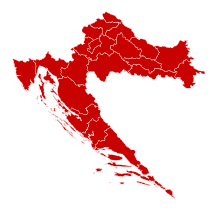Healthcare in Croatia
Croatia has a universal health care system, whose roots can be traced back to the Hungarian-Croatian Parliament Act of 1891, providing a form of mandatory insurance of all factory workers and craftsmen.[1] The population is covered by a basic health insurance plan provided by statute and optional insurance and administered by the Croatian Health Insurance Fund. In 2012, annual compulsory healthcare related expenditures reached 21.0 billion kuna (approximately 2.8 billion euro).[2]
Expenditure
Healthcare expenditures comprise 0.6% of private health insurance and public spending.[3] In 2012, Croatia spent 6.8% of its GDP on healthcare,[4] down from approximately 8% estimated in 2008, when 84% of healthcare spending came from public sources.[5] Croatia ranked around the 50th in the world in life expectancy with 73 years for men and 79 years for women, and it had a low infant mortality rate of 6 per 1,000 live births.[4]
Institutions
There are hundreds of healthcare institutions in Croatia, including 79 hospitals and clinics with 25,285 beds, caring for more than 760,000 patients per year.[6] Ownership of hospitals is shared between the state and the Counties of Croatia.[7] There are 5,792 private practice offices, and a total of 46,020 health workers in the country, including 10,363 medical doctors.[8] There are 79 emergency medical service units that performed more than one million interventions in 2012.[9]
The Euro health consumer index placed it 16th in Europe, commenting that it did well with kidney transplants, performing more than 50 per million per year, and speculating that it might become a health tourism destination, as a state-of-the-art hip joint operation can be had for €3000.[10]
Health
The principal cause of death in 2011 was cardiovascular disease at 41.7% for men and 55.4% for women, followed by tumours, at 31.7% for men and 22.8% for women.[11] In 2012 only 20 Croatians had been infected with HIV/AIDS and 6 had died from the disease.[12] In 2008 it was estimated by the WHO that 27.4% of Croatians over age of 15 are smokers.[13] According to 2003 WHO data, 22% of the Croatian adult population is obese.[14] It had the second lowest rate of death from communicable diseases in Europe (12 per 100,000) in 2015.[15]
| 2020 coronavirus outbreak in Croatia | |
|---|---|
 Map of counties with confirmed or suspected coronavirus cases (as of 28 February) | |
| Disease | COVID-19 |
| Virus strain | SARS-CoV-2 |
| Location | Croatia |
| First outbreak | Milan, Italy |
| Index case | Zagreb |
| Arrival date | 25 February 2020 (1 week and 4 days) |
| Confirmed cases | 7 |
| Recovered | 0 |
Deaths | 0 |
2020 COVID-19 Presence in Croatia
On 25 February, Croatia confirmed its first case. A 26-year-old man who had stayed in Milan, Italy from 19 to 21 February tested positive and was hospitalised at the University Hospital for Infectious Diseases Dr. Fran Mihaljević in Zagreb, Croatia.[16] On 26 February, two new cases were confirmed. The second case involved the twin brother of the individual on the first case. He was also admitted to the same hospital.[17] The third case involved a Croatian man who worked in Parma, Italy. He was hospitalised in Rijeka.[17]
As of 29 February, there were seven confirmed cases in Croatia.[18] As of 4:10pm, March 17th 2020, there have been 65 cases. Four patients are currently known to be cured.
See also
- Ministry of Health (Croatia)
- List of hospitals in Croatia
- 2020 coronavirus outbreak in Croatia
References
- Siniša Zrinščak (February 2003). "Socijalna politika u kontekstu korjenite društvene transformacije postkomunističkih zemalja" [Social Policy in the Context of Thorough Social Transformation of Post-Communist Countries]. Revija za socijalnu politiku (in Croatian). 10 (2): 135–159. doi:10.3935/rsp.v10i2.124. ISSN 1330-2965. Retrieved 12 October 2011.
- 2013 Statistical Yearbook of the Republic of Croatia, p. 548
- Marijana Matković (27 September 2011). "Ulaskom u EU Hrvatska će imati najveću potrošnju za zdravstvo" [After the EU accession Croatia will have the maximum healthcare spending]. Vjesnik (in Croatian). Archived from the original on 14 June 2012. Retrieved 12 October 2011.
- "Croatia". who.int. World Health Organization. Retrieved 10 May 2015.
- Etibar Jafarov; Victoria Gunnarsson (May 2008). "Government Spending on Health Care and Education in Croatia: Efficiency and Reform Options" (PDF). International Monetary Fund. Retrieved 7 November 2011.
- 2013 Statistical Yearbook of the Republic of Croatia, p. 529
- "Croatia". European Observatory on Health Systems and Policies. Retrieved 9 February 2016.
- 2013 Statistical Yearbook of the Republic of Croatia, pp. 527–528
- 2013 Statistical Yearbook of the Republic of Croatia, p. 535
- "Outcomes in EHCI 2015" (PDF). Health Consumer Powerhouse. 26 January 2016. Archived from the original (PDF) on 6 June 2017. Retrieved 27 January 2016.
- 2013 Statistical Yearbook of the Republic of Croatia, p. 118
- 2013 Statistical Yearbook of the Republic of Croatia, p. 539
- Marija Crnjak (10 January 2008). "U Hrvatskoj se puši manje nego u EU" [Fewer smokers in Croatia than in the EU] (in Croatian). Poslovni dnevnik. Retrieved 12 October 2011.
- "Croatia". World Health Organization. Retrieved 12 October 2011.
- Ballas, Dimitris; Dorling, Danny; Hennig, Benjamin (2017). The Human Atlas of Europe. Bristol: Policy Press. p. 66. ISBN 9781447313540.
- "Croatia latest European country to confirm coronavirus case". The Guardian. 25 February 2020.
- "Croatia confirms third case of coronavirus infection". N1 HR (in Croatian). Retrieved 2020-02-26.
- "Zagreb and Rijeka take safety measures after three confirmed cases of Coronavirus in Croatia". www.themayor.eu. Retrieved 2020-02-28.
Sources
- Ostroški, Ljiljana, ed. (December 2013). Statistički ljetopis Republike Hrvatske 2013 [2013 Statistical Yearbook of the Republic of Croatia] (PDF). Statistical Yearbook of the Republic of Croatia (in Croatian and English). 45. Zagreb: Croatian Bureau of Statistics. ISSN 1334-0638. Retrieved 17 February 2014.
External links
- European Observatory on Health Systems and Policies - Countrypage Croatia
- Džakula A, Sagan A, Pavić N, Lončarek K and Sekelj-Kauzlarić K. Croatia: Health system review. Health Systems in Transition, 2014;16(3):1–162. ISSN 1817-6127
- Government of the Republic of Croatia. National Health Care Strategy 2012-2020
- Croatian Institute for Health Insurance (Croatian)
- Ministry of Health and Social Care of Croatia (Croatian)
- "Razvoj zdravstvenih ustanova u Hrvatskoj do Prvoga svjetskog rata" (in Croatian). Retrieved 23 August 2012.
- "Zdravstvena politika Hrvatske. U vrtlogu reformi i suvremenih društvenih izazova" [The Croatian Health Policy. In the Whirlpool of Reforms and Contemporary Social Challenges] (in Croatian). Retrieved 23 August 2012.
